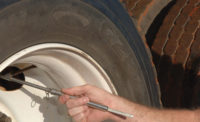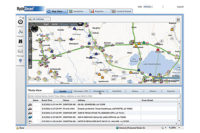It’s fairly common in business, psychology and elsewhere to incentivize the type of behavior one desires. Within the beverage industry, sales and marketing departments rely on numerous incentive programs, both internally with staff and externally with retailers. However, only a small fraction of the fleets I have contact with have any type of incentive programs for their drivers.
Among fleets with driver incentive programs, the majority are focused on safety alone, with just a few addressing fuel economy or other direct operational costs.
Although safety is the top priority for every fleet, and an important element of a good driver incentive program, it’s more of a corporate-culture goal than an option for controlling the direct operational costs of a fleet that can be measured and managed.
Where rubber meets the road
With tires ranking as the top maintenance cost for most fleets, they often are overlooked as an opportunity for a driver incentive program.
Whether tire costs are tracked by driver or across the entire fleet, improvement from a baseline cost of unscheduled tire repairs can be the basis for an individual driver to earn recognition such as a higher ranking, special logo-wear, or a cash bonus. On a fleet-wide basis, incentives could be a bigger budget for the annual company picnic.
Another possibility for a tire incentive program reward would be to involve your fleet’s tire supplier and give the driver with the best tire performance a free set of tires for his or her personal vehicle. The key here is that, by using a little imagination, incentivizing your drivers to keep tire costs in check can deliver significant bottom-line results.
Fueling improved behavior
As fuel typically is the single-largest operating cost for most fleets, improving fuel economy should be a top metric for any driver incentive program. It’s also one of the easiest operating costs to measure. For example, modern engine computers and fuel-dispensing systems can deliver accurate fuel consumption statistics in near real-time, but a fuel economy incentive program can even be effective with far less technology.
When I ran my own small fleet, I equipped each driver with a paper ledger book to record fuel purchases and odometer readings and a cheap solar calculator to calculate miles per gallon. Relying on the popularity of bragging rights among drivers, I had created a self-managing fuel economy incentive program for the total annual cost of about $5 a truck. This is just one example that shows incentive programs don’t necessarily require monetary rewards.
A frequent reason given for not having a fuel economy incentive program is that some fleets have a logistical need to move drivers between trucks too frequently to allow attribution of fuel consumption to any one driver. Although this could complicate the process somewhat, it doesn’t necessarily preclude a fuel economy incentive program. In this case, the metric for the incentive program can be based on improvements to a fleet-wide average measure of fuel economy or even a competition between operating divisions for the biggest improvement.
Safety pays
Although safety incentives might not deliver a measurable financial return in the short term, truck accidents easily can make up in cost what they lack in frequency.
According to statistics for 2012 from the Federal Motor Carrier Safety Administration (FMCSA), the average cost of a commercial vehicle crash was just less than $267,000. For non-fatal injury crashes, the number jumps to more than $447,000, and for a fatal crash, the average is just more than $10.8 million for each crash.
Even if a fleet only experiences one major crash every few years, the cost easily can exceed the savings derived from fuel, tire and other operating cost incentive programs, so promoting safety should be a key element of any driver incentive program.
Many beverage fleets have well-developed safety programs, but only a minority incorporate any positive driver incentives in those safety programs.
As a practical necessity, most fleet safety programs include negative incentives for unsafe operation and/or preventable accidents, with elements including remedial training, suspension or even termination, but this can be too little, too late. An effective safety program will prevent unsafe operation and accidents before they occur.
Recognizing the best
Beyond any fleet-wide incentives for achieving or exceeding specific metrics, another popular incentive program involves recognizing one or more drivers who exhibit the best overall performance and/or improvement with a Driver of the Year award.
Ryder System Inc., Miami, employs and manages many drivers through its supply chain solutions and fleet management solutions divisions and each year recognizes the drivers in each division who have best demonstrated exemplary safety performance, customer service and citizenship with its Driver of the Year awards. A committee that includes Ryder customers, executives, safety experts and professional drivers selects the honorees after a rigorous review process.



